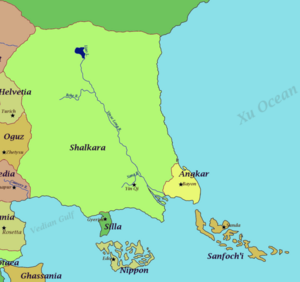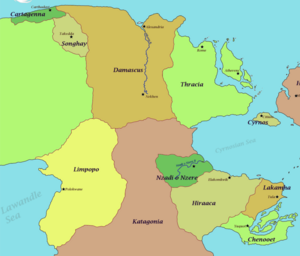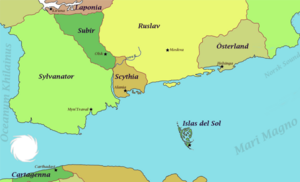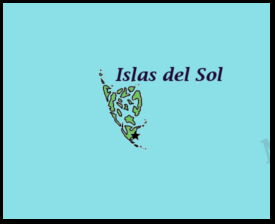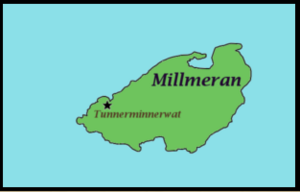Nations and Lands
Overview of the Game World
The game world that the characters of Legacies inhabit has almost as many names as cultures, though the most common is Terra, after a goddess who is believed to have died and formed the world with her body. Some parallels between Terra and the real world exist; certainly many of the cultures and lands within it were influenced by some real world counterpart, and for the sake of simplicity the calendar used to track dates and the names of the week have a striking similarity to the calendar and days used by players when not at game. However there are also a great deal of differences between Terra and the Earth players know. The most obvious are the presence of magic, a multitude of different sentient species, and a menagerie of dangerous denizens that the real world has not been confronted with. Less immediately apparent, Terra's distinct history and geography has given rise to circumstances very different than those found in the real world.
Immediate Setting
The player characters of Legacies live in the frontier town of Fortnight, a rough and tumble settlement near the boarder of the Goblin Wastes. Adversity frequently flows south from the Wastes to challenge the town, with the town's residents standing steadfast against the threats. Fortnight is in the Earldom of Drackenvelt, which is in turn in the nation of Warwick. Warwick is a fairly recently formed nation that until recently was a duchy belonging to the nation of Alba, though the land and its inhabitants have a long and storied history predating Alban governance.
Modern Nations and Lands
The land a character has grown up in has as much impact on the character's life as the race they belong to. Each land presents different cultural and geographic influences, and the character's experience growing up there will be heavily influenced by where they were in the social caste of the land, as well as how their particular race was commonly viewed and treated in that land.
Eurus
With climate running the full gamut of possibilities, this continent is dominated by the vast Goblin Wastes that occupy fully a third of the landmass in the north. That region of impenetrable chaos and twisted magic is people by an assortment of monstrous beings and unspeakable abominations, but also has a large population of what are dubbed the “Goblinoid” races; Ogre, Orc, and Goblin peoples living on the fringes. The rest of the continent (and nearby islands) is comprised of the nations of Abruzzo, Alba, Angkar, Doomstadt, Helvetia, Inishmora, Malay, Nippon, Nordehavn, Oguz, Sanfoch’i, Shalkara, Silla, Skollar, and Vedia. Bisected by a vast mountain range called the Dragonspine, Eurus is most readily split into two subsections. The western portions are very European in character, while the eastern portions are very Asian.
West Eurus
- Abruzzo is a collection of principalities along the southern coast of Eurus near its juncture with the continent of Coda. Temperate and prosperous, this aggregation of city-states is peopled predominantly by Humans and is one of the more racially exclusive regions in Eurus. The real world cultural influences at work in Abruzzo are predominantly the states that made up Renaissance Italy.
- Alba is the country that, as stated above, serves as home for the game setting of Legacies. It includes both the Island of Alba and a lard portion of land in the north of Eurus adjacent to the Goblin Wastes known as the Kingdom of Warwick. The population is predominantly Human with a modest minority of Gael’braugh in the upper class. Demographics are steeply altered when including Warwick, however, as it is a wild frontier melting pot which, while still predominantly human, has a stout minority population of absolutely everything else under the sun. The isle of Alba itself and the history of the country have a lot drawn from the historical flavor of England. Warwick, culturally, is a chaotic blend of concepts that mingle the American Old West with colonialism and Poland.
- Doomstadt, located in the northwest of Eurus, is the homeland of the Endrani people. They represent the bulk of the upper class in the country but are a minority when compared to the formerly enslaved lower classes, a blend of human and other races who remain in sub-optimal societal conditions. Culturally, Doomstadt blends aspects of late Renaissance Italy and Prussia while leaning heavily on concepts associated with a Dungeons and Dragons race which the Endrani resemble.
- Helvetia is a mountainous kingdom located in the Dragonspine Mountains. It is peopled largely by Humans and Dverg, and is renowned for its strong defensive posture and disinclination to be involved in geopolitics. Culturally it is modeled on the history of Switzerland.
- Inishmora is the second large Island nation located in the Mari Magno or “great sea” around which the world of Terra is arrayed. It benefits from warm currents to have a greener and more forgiving climate than its neighbor Alba and is populated by mostly Human peoples with a decent minority of Gael’braugh nobility and some dwindling Outlander peoples. Modeled largely on real-world Ireland, Inishmora also includes elements of Scottish culture and history.
- Malay is located on the southwest side of Eurus and has a generous and temperate climate. Its population is largely human with Gael’braugh scattered amongst the upper-classes, much like both Alba and Inishmora with whom it was formerly combined in the historical Empire of Imajicka. Based on real-world France, Malay naturally has a historical rivalry with Alba.
- Nordehavn is located in the extreme northwest of Eurus and spills over into the continent of Boreas as well. The land ranges from fjord to tundra and is generally unforgiving. It is not a single political entity but represents a swath of territory dominated by the mostly Outlander Norsk people. Nordehavn draws culturally from the Viking period of Scandinavian history.
- Oguz is located in the southern reaches of the Dragonspine Mountains and is a mixture of arid and temperate highlands. It is peopled by a blend of Human and Ogre populations who coexist better there than elsewhere without turning into an apartheid state. Culturally the influences are varied and include nods to Kazakhstan and former Soviet republics in the same geographical area.
- Skollar is a small and beleaguered kingdom encircled by Nordehavn in the northwest of Eurus. It occupies a region called the Grey Coast up in the gulf of Nordehavn, and is all that remains of a much larger kingdom which was occupied and integrated into Nordehavn’s political norms in very recent years (circa 2010). Its population is mostly Human and Outlander with small but meaningful minorities that include Paleteth, Half-Fae, and Canid. Skollar draws culturally from the Oldenburg Monarchy of early modern Denmark-Norway, but with strong fantastical underpinnings.
- Vedia is located at the southern end of the Dragonspine mountains, on the east side of the southern extent that borders Abruzzo to the west. It has a subtropical climate and occupies a profoundly advantageous location as a gateway to trade with the eastern half of the continent. The population is predominantly human with a strong minority of Canid, Felinae, and bestial Mongrel peoples who are more welcome there than anywhere else in the world. Vedia draws culturally on the pre-colonial history of the Indian subcontinent.
East Eurus
- Angkar, located in the far southeast of the continent, is a mix of temperate and semi-tropical rainforest and mountain countries with a population that is mostly Human. It has a distinctly matriarchal class structure but draws cultural history otherwise from the traditions of southeast Asia and particularly the historical Khmer empire.
- Nippon, also known as the Empire of Nippon, is composed of a collection of islands of the southern coast of Eurus. Oceanic idiosyncrasies make for a varied, rather than consistently subtropical, climate and the island is peopled almost exclusively by Humans. The imperial family of Nippon is composed of Dragoons, however, and is claimed to have been so since the beginning of time. Nippon is based on historical Japan.
- Sanfoch'i is a large island chain located off the southeast coast of Eurus. Like several “countries” on this list, Sanfoch’i is not a single political unit but a region defined by cultural characteristics with many smaller nation-states within it. The population is a mixture of Human, Outlander, and Trandafir peoples with an assortment of half-breed people from other races. Sanfoch’i combines the cultural character of Indonesia and Asian-pacific islands.
- The Empire of Shalkara, also called the Shalkaran Empire, is the largest single political unit on the face of Terra. It spans a huge portion of the landmass of Eurus and ranges from tropical forest to mountainous highland to arid steppes all within one governing body. The population is mostly human with assorted stand-out minorities that vary regionally. It draws culturally on real-world China.
- Silla occupies a peninsula off the southern side of Shalkara near Nippon. It’s population is predominantly Human with a substantial Dragoon minority, and it is based culturally on historical Korea.
Coda
Located off the southern end of Eurus is the continent of Coda (once called by Thracian geographers “Coda Draconem,” the Dragon’s Tail to go with the Dragonspine Mountains, but long ago shortened for clarity). The curving mass of this enormous peninsula is composed of the nations of Hispalis, Ghassania, Nabotaea, Saimonia, Sassania, and Uthmanli. It also is generally considered to include the island nations of Melite and Cyrnos. The interior coastline of Coda is called the Berrylian Coast, and the water it encircles the Beryllian Gulf, in reference to the Thracian god of wealth and prosperity, because of the robustness and ease of trade through the region. It draws a great deal on the real-world Middle East and other parts of the Mediterranean for cultural background.
- Cyrnos is a large temperate island between Hispalis and Thracia. It is populated by a Human and Endrani plurality, being the location of a substantial Endrani Hegira several centuries ago and having developed independently from Doomstadt since. While named in deference to the island of Cypress it has more generally Mediterranean cultural connections.
- Ghassania is a substantial peninsula off the eastern coast of Coda. Arid and unforgiving, the country nevertheless has a strong position for trade to the east and valuable mineral resources. The population is a mix of Human and Barabian with a large Gael’braugh minority exclave. Its cultural inspiration in the Arabian peninsula.
- Hispalis(empty) is a very large and advantageously placed nation at the west end of the Coda. With a mountainous interior and balmy temperate coastlines in three directions, it is a powerhouse both of production and trade and has some amount of expansionist history. The population is majority Human with some Outlander. Hispalis draws primary cultural inspiration from Spain and Portugal.
- Melite is a smaller island punctuating the northern boundary of the Beryllian Gulf. While majority-Human as most nations tend to be, it has a higher than normal racial blend due to its intersectional positioning. Melite has a temperate climate and shipbuilding-related economy. It draws some cultural influences from Malta.
- Nabotaea is a narrow strip of nation on either side of the extremely important waterway known as the Azar which is the locus of all east-west trade shipping in the world. This positioning means it’s been a hotly contested bit of land for all of recorded history. The population is predominantly Human with a high minority of Trandafir. Nabotaea gets cultural inspiration from Isarael, Jordan, and Sinai.
- Saimonia (empty) is a desirable bit of mountainous real estate in the western Coda which has a long history of disputed political status generally sectioned into three or more polities at any given time. The population is a blend of Human, Outlander, and Dwarven with a substantial minority of Trandafir. It draws cultural inspiration from the history of the Balkan peninsula.
- Sassania is a large nation covering the northern expanse of Coda. It has a semi-arid to subtropical climate with a number of modestly mountainous regions. The population is almost entirely Human, making it up there with Abruzzo and Sylvanator in terms of exclusivity. Culturally, Sassania draws a lot of inspiration from the history of Persia.
- Uthmanli (empty) is the remains of a formerly much larger empire that had a span of time controlling most of Coda. Like many Coda nations it has a blend of Human and Outlander with some element of Trandafir residents. The climate is semi-arid to the south and more generously subtropical to the north, with an unforgiving range of mountains isolating the northern coastline from much of the rest of the territory. Uthmanli is culturally informed by the early history of the Ottoman empire.
Meridia
Located to the west of Coda is the massive continent of Meridia. Like Eurus, it is nearly bisected by a massive mountain range, and like Eurus this creates a substantial barrier of trade and understanding between the two halves. Large enough to support a variety of climates it is most particularly notable that the entire western end of the continent is a massive and impenetrable desert whose boundaries beyond what is shown above are not understood. That desert is peopled entirely by Demons and cannot be explored, so its actual dimensions remain unclear. The continent is composed of the nations or regions of Cartagenna, Chenooet, Damascus, Hiraaca, Kategonia (Cuauhtla), Lakamha, Limpopo, Nzadi o Nzere, Songhai, and Thracia. Generally speaking, western Meridia draws substantially from different regions of Africa for cultural background, while Eastern Meridia is divided into Mediterranean influences in the north and New World influences in the south.
- Cartagenna is a nation that represents the cut-off westernmost point of past Thracian expansionism. In addition to a normal Human majority, it features a strong Outlander minority and a more substantial than usual amount of Half-Fae. Culturally it draws influence from Morocco and Tunisia, or more generally coastal North Africa.
- Chenooet is predominantly a peninsula at the southeastern extent of Meridia. It has a very mild and temperate climate with a mixture of mountainous woodland and estuary. The people are predominantly Outlander, with strong representation for Canid and avian Mongrel types. Culturally it draws influence from Pacific Northwest indigenous populations such as the Salish.
- Sultanate of Damascus is a large arid confederacy in the north of Meridia dominated by the Nikerian river, well understood to be the largest and longest river in the world. The population is mostly Human, Outlander, and Felinae, with Felinae making up a larger proportion than in any other nation outside their own forests. It is culturally inspired by pre-Ptolemaic Egypt.
- Hiraaca is a large region with a temperate-to-tropical swath of climate. It is predominantly lowland plains without any major mountain ranges, and the inhabitants have a certain mobility and thematic consistency that cause them to be grouped together while not actually being a political unit. Predominantly Outlander, there are also substantial canid groups in Hiraaca, which draws cultural influence from the North American plains cultures as well as Mesoamerican lost civilizations.
- Katagonia (Cuauhtla) is the vast and impenetrable forests and forested mountains that separate north from south and east from west in Meridia. The climate is tropical jungle in the northern reaches to more temperate forestlands farther south, but the mountainous territory is almost impossible to traverse. It is peopled almost entirely by Felinae who have no qualm about consuming interlopers. It is thought to contain ruins of past civilizations, but the Felinae who reside there are not thought to be particularly civilized themselves. The cultural flavor tends to draw somewhat from Mesoamerican lost civilizations.
- Lakamha is a temperate and mostly coastal region in southern Meridia that is characterized by dense forests. It has a majority Outlander population with a strong presence of Ogres, providing an international (dubious) reputation for cannibalism, as well as several orderly Hispalian colonies. Culturally it draws somewhat on east American indigenous populations.
- Limpopo is a very large region far enough from reliable cartography to be subdivided into an unknown number and variety of political subunits. While it has a substantial western coastline, this abuts a body of water that is entirely unexplored even to the extent of knowing if it is an inland salt sea or an ocean. The population is a majority blend of Human and Outlander with a wide and diverse set of regional minority populations that incorporates almost all races to a substantial degree except the Sidhe who are uncommon. Difficult to access, it has a varied climate and exotic wildlife as well as a broad range of cultural antecedents. Limpopo is the game world analog to sub-saharan Africa.
- Nzadio Nzere is a dense, jungled river valley in eastern Meridia that descends from the mountans of Kategonia to the Cyrnosian sea. It is populated by a mixture of Human, Outlander, and Felinae in varying densities, but is not a populous nation or a well definitely political territory. Culturally, it represents a synthesis of Amazonian and Congolese precolonial history.
- Songhai is one of the more clearly defined political units of Meridia, being a long-standing remnant of a formerly very large empire. With a blend of arid and subtropical climates, Songhay has a fruitful coastline and inland mineral wealth, with a history of access to Limpopo that creates a unique economic status for the kingdom. Culturally it references pre-colonial North and West African empires.
- Thracia Unitas is the lingering remains of the largest empire in the recorded history of Terra. A stable conglomerate of multiple ancient city states united by common economic interest, Thracia has a generous sub-tropical climate and almost unparalleled positioning to trade with the entire world. Culturally it is inspired by the Roman Empire in late antiquity.
Boreas
In the Northwest lies the continent of Boreas. With a climate ranging from temperate to arctic, Boreas is comprised of the nations of Laponia, Osterland, Ruslav, Scythia, Subir, Sylvanator, and the western end of lands claimed by Nordehavn. Each of these has a rich character and history of its own, but can in some ways be simplified for a first-glance out of game reading by considering cultural parallels used to develop the background of these nations.
- Laponia is a land composed of arctic snowscapes and isolated austerity populated by Human, Gael’braugh, and Half-Fae denizens with a long history together. Culturally it draws on the Laplander regions of Scandanavia in the real world.
- Osterland is located in the eastern part of Boreas and has undergone a great deal of conquest from east and west in a tumultuous history. It is peopled mostly by Humans and Outlanders but with minorities of Goblin, Orc, and distinctly ursine Mongrels. The best real-world parallel for the culture of Osterland is Finland.
- Ruslav is a vast nation with a long and troubled history of expansion and contraction. As the name suggests it draws culturally on the history of real-world Russia. The majority of the population is Human or Outlander, but there is a substantial and well-integrated population of Goblins in Ruslav as well.
- Scythia is a flourishing country in the more temperate reaches of Boreas with strong seaports and robust trade with neighboring nations. It is populated predominantly by Human and Outlander peoples and draws a strong influence from the real world parallel of Ukraine.
- Subir is located in the lowlands between Sylvanator and Ruslav, a fruitful lowland country with a rich and diverse population of Human, Gael’braugh, Canid, and Palateth citizenry. While it draws from the history of real-world Siberia to a certain extent, it is also influenced strongly by its In Game history of being a former portion of Laponia and clearinghouse where many cast off by the society of neighboring nations find refuge.
- Sylvanator is the ancient homeland of the Gael’braugh people. Densely forested and peopled almost exclusively by the reclusive and xenophobic Sidhe, Sylvanator has more in common with J.R.R. Tolkein’s Lothlorien than any nation found in the real world.
Island Nations
- Los Islas del Sol is a loosely affiliated collection of islands in the middle of the Mari Magno with great variety of character amongst them, with a tendency towards artful anarchy. Substantially colonized and re-colonized by every wave of persons attempting to dominate North-South trade routes, the end result has been chaotic and diverse. Large populations of Human, Outlander, and Felinae are prominent, as well as groups of Ogre, Trandafir, and a substantial Taelgranis exclave. Culturally the islands draw a great deal from romanticized concepts of the Caribbean.
- Millmeran is a very large island located inaccessibly far to the southeast of Eurus. Intermittently colonized by ambitious prospectors who were subsequently abandoned by their parent nations due to expense and difficulty, Millerman is an island where a dominant indigenous Outlander culture coexists politely with the humbled remnants of erstwhile invaders. While the climate is varied, the appallingly deadly nature of local wildlife is less so. Millmeran draws cultural inspiration from Australia.
- Subtellurium is the homeland of the Taelgranis people. A network of caverns accessible only by going farther underground than even Dvergen enterprise would dare attempt, the Subtellarium is located in another realm or plane of existence, essentially a very firmly-rooted suburb of the Fae realm. It has distinct ecology and extremely exotic wildlife but does not suffer from the geological difficulties one would expect from actually delving miles beneath the soil of Terra. It is organized around a single central capital city of Elysian somewhere underneath Alba with an extended network of largely natural caverns and connecting tunnels accessing satellite towns and communities beneath a diffuse region of western Eurus. In recent years (beginning 2016) something has begun to destabilize, alter, or destroy remote regions of the Subtellarium resulting in Taelgranis refugees becoming more common on the surface.
- Dvergen Kingdoms (empty) Ironbeard, Steelbright, and Stonehelm are the three primary kingdoms of the Dvergen people, located in caverns dug under the Dragonspine Mountains. Ironbeard is in the northern reaches of the Dragonspine, underneath the edges of the Goblin Wastes. Steelbright is near Helvetia, and Stonehelm is farther south near Abruzzo. The Dvergen kingdoms combine natural caverns with craftsmanship and manufacture centralized city states with a scattering of more remote outposts. These remain largely isolated from surface-dwelling peoples and have no territorial claim above ground. All three kingdoms can be accessed by exclusive use of tunnels constructed over the millenia by Dvergen ingenuity, but the paths are neither direct nor practical.
Historical Nations and Lands
There are a myriad of lands and nations that rose to prominence at some point in history, only to slowly (or abruptly) decline. While they may be no more, their influence is still strongly felt among the people of Terra, and a number of modern nations can trace their lineage to the nations of old.
- Achaemenid Empire
- Imajicka
- Thracian Empire
- Krecian City States
- Nikirian Empire
- Five Kingdoms of Shalkara
Languages
The lands and people of Terra have developed a diverse set of languages in which to communicate with. Many of the countries have real world analogs in which a language can be drawn from. For example, Shalkara is an amalgamation of China and India, and any of the languages present in those regions of the real world can be assumed to be dialects spoken somewhere within the border of Shalkara. Likewise, Nippon is analogous to Japan, and Nipponjin, the language of Nippon, is remarkably identical to traditional Japanese. English is assumed to be Alban, the language once spoken by all of the nations that composed Imajicka, however many of the countries formerly of Imajicka are reverting to their traditional languages (French for Malayan, the language of Malay, Gaelic for Inishmoran, the language of Inishmora).
Other languages are completely unique to the Legacies game world. Most of the races would traditionally speak a language with no real world counterpart. Whether the language is completely imaginary, like the whispered tongue of the Sidhe Taelgranis, or simply a renamed real world language, characters may not speak the language unless the player is actually speaking the language. It is not acceptable for two players to converse in plain English, but inform eavesdroppers that they would not understand the conversation unless they spoke Nipponjin, nor is it acceptable for a player to overhear two other players speaking in a foreign tongue to ask those players for a translation because their character should understand that foreign tongue.
This can be frustrating for players who wish to play a character from a given land, but have no affinity for that land’s language. Very few players converse in anything but English at Legacies, so typically this is not an issue, however a variety of explanations could be put forth to explain a character’s lack of knowledge concerning their native tongue. For example, the player could have left the land at a young age and lost a great deal of affinity for their birth language, or they could have suffered a blow to the temporal region of their brain, damaging their language centers and requiring them to relearn a language.

